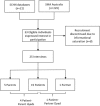"Getting ready for the adult world": how adults with spinal muscular atrophy perceive and experience healthcare, transition and well-being
- PMID: 30940178
- PMCID: PMC6446316
- DOI: 10.1186/s13023-019-1052-2
"Getting ready for the adult world": how adults with spinal muscular atrophy perceive and experience healthcare, transition and well-being
Abstract
Background: Spinal muscular atrophy (SMA) has profound implications across a lifetime for people with the condition and their families. Those affected need long-term multidisciplinary medical and supportive care to maintain functional mobility, independence and quality of life. Little is known about how adults with SMA experience healthcare, or the components of care perceived as important in promoting well-being. The purpose of this study was to use qualitative research methodology to explore the lived experiences of healthcare and wellbeing of adults with SMA. Purposive sampling was used to recruit adolescents and adults with SMA, their parents and partners. Face-to-face or telephone-based semi-structured interviews were recorded and analysed using inductive thematic analysis.
Results: Across a total of 25 interviews (19 people with SMA, 5 parents, 1 partner) many participants described disengagement from health services and major gaps in care throughout adulthood. Disengagement was attributed to the perceived low value of care, as well as pragmatic, financial and social barriers to navigating the complex healthcare system and accessing disability services. Adults with SMA valued healthcare services that set collaborative goals, and resources with a positive impact on their quality of life. Mental health care was highlighted as a major unmet need, particularly during times of fear and frustration in response to loss of function, social isolation, stigma, and questions of self-worth. Alongside this, participants reported resilience and pride in their coping approaches, particularly when supported by informal networks of family, friends and peers with SMA.
Conclusions: These findings provide insight into the lived experiences, values and perspectives of adults with SMA and their carers, revealing major, ongoing unmet healthcare needs, despite many realising meaningful and productive lives. Findings indicate the necessity of accessible, patient- and family-centered multidisciplinary care clinics that address currently unmet physical and mental health needs. Understanding the lived experiences of people with SMA, particularly during times of transition, is critical to advancing health policy, practice and research. Future studies are needed to quantify the prevalence, burden and impact of mental health needs whilst also exploring potential supportive and therapeutic strategies.
Keywords: Complex care; Disability; Family-centered care; Health services; Lived experience; Mental health; Patient-centered care; Quality of life; Spinal muscular atrophy; Transition.
Conflict of interest statement
Ethics approval and consent to participate
Ethics approval was granted by the Sydney Children’s Hospitals Network Human Research Ethics Committee (SCHN HREC) on 6/12/2017 (HREC Number: LNR/17/SCHN/441). All participants gave verbal and written consent for participation in the study and the publication of the findings prior to conducting the interviews.
Consent for publication
Not applicable.
Competing interests
Dr. Farrar has served on the scientific advisory board for Biogen.
Publisher’s Note
Springer Nature remains neutral with regard to jurisdictional claims in published maps and institutional affiliations.
Figures
Similar articles
-
Palliative care experiences of adult cancer patients from ethnocultural groups: a qualitative systematic review protocol.JBI Database System Rev Implement Rep. 2015 Jan;13(1):99-111. doi: 10.11124/jbisrir-2015-1809. JBI Database System Rev Implement Rep. 2015. PMID: 26447011
-
"The Whole Game is Changing and You've Got Hope": Australian Perspectives on Treatment Decision Making in Spinal Muscular Atrophy.Patient. 2020 Aug;13(4):389-400. doi: 10.1007/s40271-020-00415-w. Patient. 2020. PMID: 32266662
-
Perspectives on Spinraza (Nusinersen) Treatment Study: Views of Individuals and Parents of Children Diagnosed with Spinal Muscular Atrophy.J Neuromuscul Dis. 2019;6(1):119-131. doi: 10.3233/JND-180330. J Neuromuscul Dis. 2019. PMID: 30594933
-
Health, wellbeing and lived experiences of adults with SMA: a scoping systematic review.Orphanet J Rare Dis. 2020 Mar 12;15(1):70. doi: 10.1186/s13023-020-1339-3. Orphanet J Rare Dis. 2020. PMID: 32164772 Free PMC article.
-
Emotions experienced by parents whose children have spinal muscular atrophy: A qualitative research.J Pediatr Nurs. 2025 Jan-Feb;80:e111-e119. doi: 10.1016/j.pedn.2024.11.027. Epub 2024 Dec 6. J Pediatr Nurs. 2025. PMID: 39645418 Review.
Cited by
-
Investigating attitudes toward prenatal diagnosis and fetal therapy for spinal muscular atrophy.Prenat Diagn. 2022 Oct;42(11):1409-1419. doi: 10.1002/pd.6228. Epub 2022 Sep 3. Prenat Diagn. 2022. PMID: 36029101 Free PMC article.
-
Healthcare transition practices of occupational therapists in South African public healthcare.Afr J Disabil. 2024 Aug 29;13:1413. doi: 10.4102/ajod.v13i0.1413. eCollection 2024. Afr J Disabil. 2024. PMID: 39229350 Free PMC article.
-
Areas of improvement in the medical care of SMA: evidence from a nationwide patient registry in Germany.Orphanet J Rare Dis. 2023 Feb 21;18(1):32. doi: 10.1186/s13023-023-02639-z. Orphanet J Rare Dis. 2023. PMID: 36810103 Free PMC article.
-
Evaluating Perceived Fatigue within an Adult Spinal Muscular Atrophy Population.Neurol Ther. 2023 Dec;12(6):2161-2175. doi: 10.1007/s40120-023-00552-y. Epub 2023 Oct 19. Neurol Ther. 2023. PMID: 37856000 Free PMC article.
-
Quality of life data for individuals affected by spinal muscular atrophy: a baseline dataset from the Cure SMA Community Update Survey.Orphanet J Rare Dis. 2020 Aug 24;15(1):217. doi: 10.1186/s13023-020-01498-2. Orphanet J Rare Dis. 2020. PMID: 32838797 Free PMC article.
References
Publication types
MeSH terms
Grants and funding
LinkOut - more resources
Full Text Sources
Medical
Molecular Biology Databases



